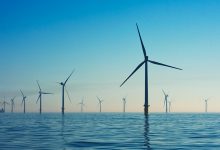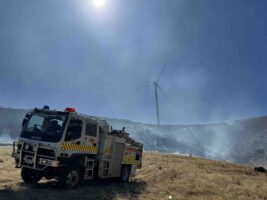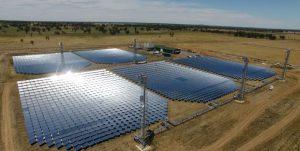The cost of wind power could drop by half or more over the next 30 years, allowing wind to play a bigger role in future electricity networks around the world than previously thought, a new paper published in the journal Nature Energy finds.
Offshore wind, which is more expensive and therefore much less common than onshore wind, will see the most dramatic price falls. Much bigger turbines will increase the capacity threefold, creating economies of scale that will drive the cost energy per megawatt hour down.
Floating offshore wind – currently the rarest and most expensive form of wind power – is predicted to become much cheaper, and could make up a quarter of all offshore developments by 2035.
These improving costs could significantly expand the potential sites for economically viable offshore wind farms, as they won’t be so constrained to areas where both the wind is suitable and the water is shallow enough to fix them to the ocean floor.
The paper, led by the Lawrence Berkeley National Laboratory in the US with input from a range of other academic institutions, surveyed 140 wind energy experts, a process known as “expert elicitation”. It found a mixture of factors, in particular turbine size, would drive down the cost of wind by between 37 and 49 per cent by 2050.
That represents a 50 per cent improvement in the outlook compared to a similar study carried out in 2015. It is yet another instance of the tendency to massively underestimate the cost trajectory of renewables over time, and bodes well for other technologies, such as utility-scale batteries and green hydrogen.
The experts predicted cost reductions across all three forms of wind power: onshore, fixed bottom offshore, and floating offshore.
Experts said fixed bottom offshore wind was likely to see the biggest fall in costs, with a median cost fall of 49 per cent and the most optimistic scenarios putting it at 64 per cent.
Floating offshore had a median price fall of 40 per cent and maximum of 56 per cent, and onshore had a median price fall of 37 per cent and maximum of 54 per cent.

By 2035, costs across all three categories are likely to fall between 38 per cent and 53 per cent.
In dollar terms, calculated as the levelised cost of energy (LCOE) in real 2019 US dollars per megawatt-hour (MWh), onshore wind will remain the cheapest form of wind, followed by fixed bottom offshore, then floating offshore.

Cost factors contributing to the overall cost included upfront capital cost, ongoing operating costs, capacity factor, project design life, and cost of financing. The experts said savings were expected in all five categories.
But the report found turbine size would be a “key driver” of cost reduction. For onshore wind, generator ratings are expected to jump from an average 2.5 megawatts in 2019 to 5.5 MW in 2035. Rotor diameters and hub heights are also expected to increase.
Offshore wind is expecting an even bigger increase, from an average 6MW in 2019 to 17 MW on average in 2035. The report found floating offshore wind would increase in market share, reaching up to to 25 per cent of new offshore wind projects by 2035.

“Wind has experienced accelerated cost reductions in recent years, both onshore and offshore, making previous cost forecasts obsolete. The energy sector needs a current assessment,” said Ryan Wiser, senior scientist at Berkeley Lab.
“Our ‘expert elicitation’ survey complements other methods for evaluating cost-reduction potential by shedding light on how cost reductions might be realised and by clarifying the important uncertainties in these estimates.”
Another of the paper’s co-authors, Joachim Seel, also of Berkeley Lab, said: “All else being equal, these trends will enable wind to play a larger role in global energy supply than previously thought while facilitating energy-sector decarbonisation. Analysts, investors, planners, and policymakers should avoid outdated assumptions and forecasts.”
According to the International Renewable Energy Agency, global wind capacity grew threefold over the last decade, ending 2020 at 733 gigawatts. The vast majority (699GW) of that was onshore wind.
Total renewable capacity, including solar, hydropower and others, stood at 2,799GW – 36 per cent of total installed capacity worldwide. Hydropower made up 1,331GW of that, and solar made up 714GW, of which almost all of it was photovoltaic. Just 6.5GW was solar thermal.
The International Energy Agency predicts solar and wind together will overtake coal as the world’s biggest source of energy by installed capacity in 2024.










